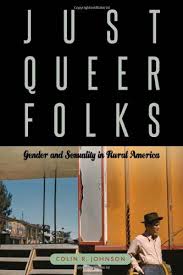 Just Queer Folks: Gender and
Just Queer Folks: Gender and
Sexuality in Rural America
by Colin R. Johnson
Temple University Press. 264 pages, $32.95
IN A 1925 STUDY, The City, sociologist Robert Park declared that “fifty years ago every village had one or two eccentric characters who were treated ordinarily with a benevolent toleration, but who were regarded meanwhile as impractical and queer.” What’s more, these odd characters were not hounded or ostracized but were generally tolerated.
It is Colin R. Johnson’s contention in Just Queer Folks that well into the early decades of the 20th century, “what looks from today’s perspective like decidedly queer behavior was anything but uncommon or unheard of in the hinterland.” Johnson—an associate professor of gender studies at Indiana University who is himself a product of a rural upbringing in western Illinois—looks at several populations in which male homosexual behavior was widely tolerated: itinerant railroad workers in remote areas of the country; all-male logging camps of the Pacific Northwest; the Civilian Conservation Corps (CCC) of the Great Depression era.
“Hobo” culture is perhaps the most interesting and entertaining of the groups under study. During the Dustbowl Era of the 1930s, same-sex sexual activity was commonplace and even recommended as a “clean” alternative to sex with women, who were thought to harbor venereal disease. There are even hints of male-to-male intimacy in Steinbeck’s Of Mice and Men, notably when George and Lennie plan to set up a home and a life together when their fortunes allow. Johnson contends that such relationships were widespread at this time and even developed their own nomenclature. Thus a “punk” was a younger man who was attached sexually to an older man, while a “fruit”—as in “low-hanging”—was an easy mark for a sexual predator.
This vocabulary points to the development of a broader consciousness of homosexual versus heterosexual patterns of behavior. The modern concept of “gay” versus “straight” can be traced to the early 20th century, which is also when gender roles were being codified and polarized. The rise of the mass media—in rural America it was all about the Sears Roebuck Catalog starting in the late 19th century—presented a concept of what “normal” people looked and acted like, while implying that departures from this image were to be scorned.
Ah, but before these notions finally took hold in the middle part of the 20th century, there were conspicuous elements of camp and drag among the men of logging camps and in the ranks of the CCC. If anything, cities were less hospitable places precisely because they had internalized “modern” notions of sexual normality and deviance. In contrast, lifelong residents of small towns tended to have a deep embeddedness in the community that superseded their sexual orientation, so that those displaying nonstandard tendencies were usually cut a fair amount of slack.
A possible objection to Just Queer Folks is anticipated by the author, who admits that his book is mostly about communities of white men. Beyond this artifact of history, Johnson has produced a book that is both well-reasoned and readable, an expedition into an often neglected area of gay and lesbian history.
________________________________________________________
Dale W. Boyer is a writer based in Chicago.






Discussion1 Comment
George Chauncey’s book Gay New York suggests that the migrant worker inner city ghettos of the industrial metropolis were also zones of tollerance for sexual minorities with the concentration of large male migrant populations reflecting the openness described here in the rural lumberjack trades.
The point here, is perhaps, similar to the ancient villages of Europe and elsewhere, rural communities had a close nit sensibility which stretched over long timesapans essentially unchanged. Such peoples naturally looked after and accommodated their own without much difficulty. Difference as such is part of the social make up of such rural cultures. The physically disabled, the mentally challenged, the lone female, male or gay and lesbian have all found places in such communities where one’s membership to family always defined before anything else.